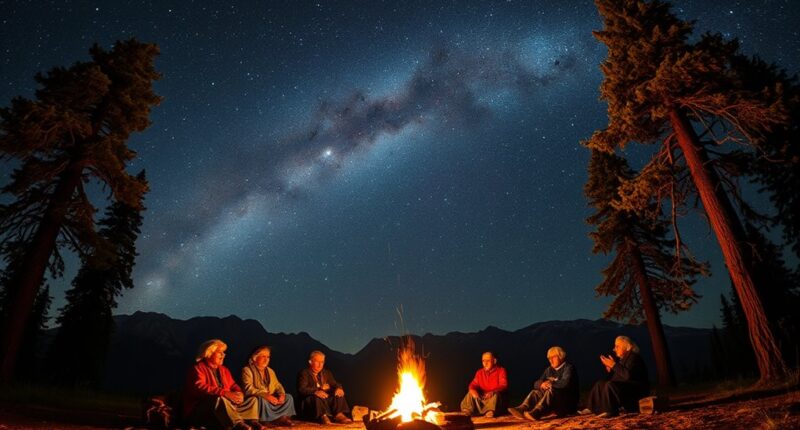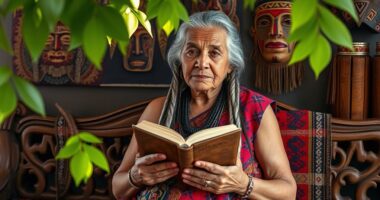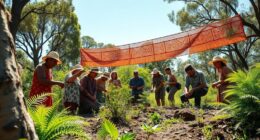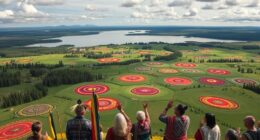First Nations peoples use the stars as a crucial guide, relying on generations of knowledge to navigate, predict seasons, and maintain spiritual ties. They observe star positions, stories, and patterns that serve as maps for travel, planting, and hunting. These celestial stories also carry moral lessons and cultural history, reflecting their deep connection with nature. If you continue exploring, you’ll discover how these traditions shape their lives and preserve their world view.
Key Takeaways
- First Nations peoples use star stories and constellations as navigational guides and seasonal markers.
- Indigenous astronomy encodes environmental cues, moral lessons, and cultural history within celestial patterns.
- Knowledge is transmitted orally through stories that link specific stars to spirits, animals, or ancestors.
- Celestial observations inform practical activities like hunting, planting, and ceremonial timing.
- Their relationship with the sky emphasizes respect, observation, and integration of astronomy into cultural identity.
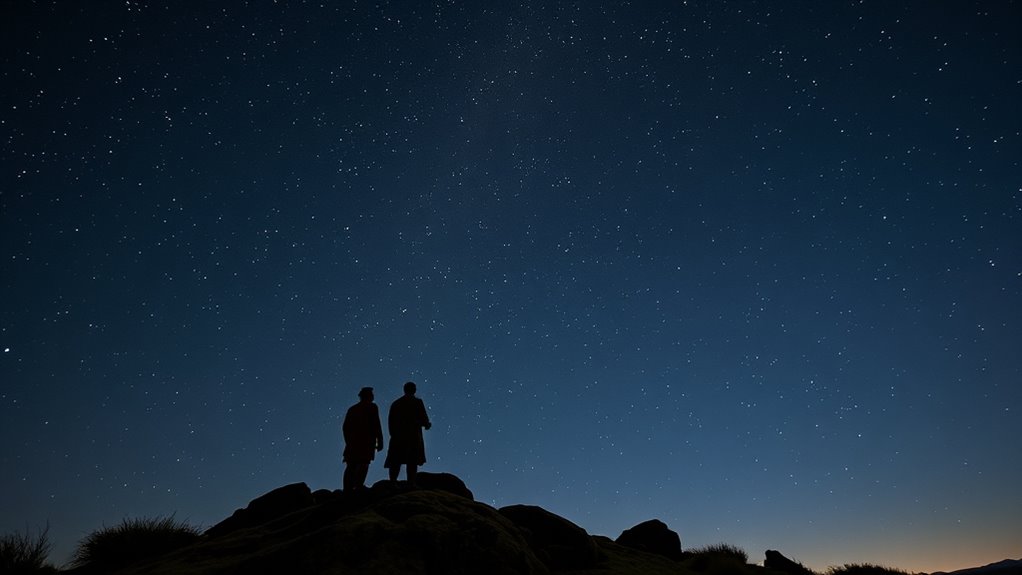
Indigenous astronomy encompasses the rich celestial knowledge and practices developed by Indigenous peoples around the world. You might be surprised to learn that many Indigenous cultures have long used the stars not only as a way to tell time but also as a guide for navigation and storytelling. You, as a reader, can appreciate how these traditions go far beyond simple star-gazing; they form an essential part of cultural identity and survival. For centuries, Indigenous communities have relied on celestial navigation, using the positions of stars and planets to guide their journeys across land and sea. Unlike modern GPS, this navigation depends on an intimate understanding of the night sky, which has been passed down through generations via oral traditions and cultural star stories. These stories aren’t just myths; they serve as mnemonic devices that help community members remember important seasonal events, migration patterns, and safe routes. You might find it fascinating that many cultures have specific stories linked to constellations, which act as celestial maps. For example, some Indigenous peoples see particular star patterns as the spirits of ancestors or animals, shaping their understanding of the world around them. These cultural star stories are more than just bedtime tales—they encode environmental knowledge, moral lessons, and history, all embedded within the sky’s patterns. When you learn about how Indigenous peoples interpret the stars, you see that the sky is a living library, offering guidance and wisdom woven into stories that have endured for generations. This celestial wisdom helps them determine planting seasons, hunt times, and ceremonial dates, illustrating a profound connection between the heavens and daily life. It’s also important to note that these traditions are dynamic; they adapt as communities move or as the night sky shifts over time. You might also discover that these Indigenous star stories often emphasize respect for nature, emphasizing harmony with the environment and acknowledging celestial bodies as active participants in life on Earth. Additionally, understanding the celestial navigation techniques used by Indigenous peoples reveals a sophisticated relationship with the cosmos rooted in observation and oral tradition. By understanding how Indigenous peoples utilize celestial navigation, you gain insight into a worldview that sees the sky not just as a collection of distant lights but as an essential part of cultural identity and practical knowledge. Their ability to read the stars with precision, guided by cultural stories, shows a sophisticated relationship with the cosmos that’s rooted in respect, observation, and oral tradition. Ultimately, this celestial knowledge enriches your appreciation of Indigenous cultures, revealing a profound way of understanding and interacting with the universe that’s both practical and deeply spiritual.
Frequently Asked Questions
How Do Indigenous Star Stories Vary Across Different First Nations Communities?
You’ll find that Indigenous star stories vary across First Nations communities because cultural storytelling and oral tradition shape each group’s unique interpretation of the skies. Different communities emphasize distinct constellations, legends, and meanings based on their history, environment, and spiritual beliefs. This diversity enriches your understanding of Indigenous astronomy, highlighting how each community’s oral tradition preserves their connection to the stars and their cultural identity through storytelling.
What Materials Did Indigenous Peoples Historically Use for Celestial Observations?
Imagine holding the night sky’s secrets in your hands. Indigenous peoples used traditional tools crafted from natural materials like bones, stones, and wood to observe celestial bodies. They relied on simple yet powerful instruments such as quills, carved sticks, and polished stones, transforming everyday items into tools that revealed the stars’ stories. These natural materials became symbols of connection, guiding their understanding of the cosmos and their place within it.
Are There Specific Indigenous Constellations Distinct From Western Star Charts?
Yes, you’ll find that many Indigenous constellations are distinct from Western star charts, often depicting mythical animals or ancestral figures. You observe how they link stars to seasonal patterns, guiding hunting, fishing, and ceremonies. These stories and shapes help you navigate and understand the natural world, emphasizing cultural significance rather than just astronomical accuracy. This unique approach showcases their deep connection to the land and sky.
How Is Indigenous Astronomy Integrated Into Cultural Ceremonies Today?
You see indigenous astronomy integrated into cultural ceremonies through storytelling and mythic connections that honor ancestral knowledge. Modern adaptations include stargazing events and educational programs that celebrate these traditions. You might participate in ceremonies that align with celestial events, reinforcing cultural identity. These practices keep the mythic connections alive, blending ancient knowledge with contemporary expressions, ensuring that indigenous astronomy remains a crucial part of cultural heritage today.
What Role Did Celestial Navigation Play in Indigenous Migration and Trade?
Celestial navigation was essential for indigenous migration and trade, guiding you across vast landscapes and open waters. You relied on stars, the sun, and other celestial cues to find your way along intricate indigenous trade routes. These navigation techniques guaranteed safe journeys, connecting communities and facilitating the exchange of goods, stories, and cultural knowledge. By mastering celestial navigation, you preserved your traditions and expanded your networks across lands and seas.
Conclusion
As you look up at the night sky, remember it’s more than just stars—it’s a ancient map woven with stories and knowledge passed down through generations. First Nations peoples read these celestial patterns like open books, guiding their lives and traditions. By honoring their wisdom, you’re reconnecting with a timeless dance of light and story. The stars are not just distant lights—they’re the heartbeat of a rich cultural tapestry waiting for you to explore.
